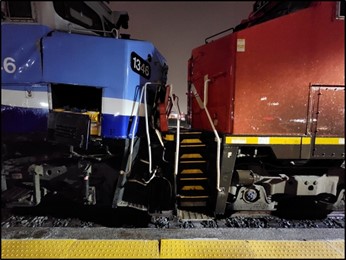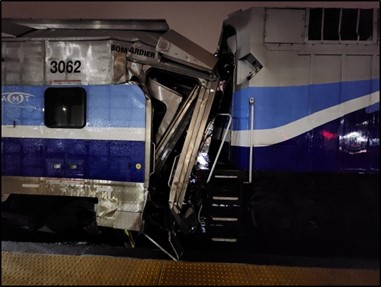Main-track collision and derailment
Canadian National Railway Company freight train X37631-20 and
Réseau de transport métropolitain (exo) commuter train EXO 1212
Mile 135.89, CN St-Laurent Subdivision
Montréal, Quebec
The occurrence
On 21 November 2023, at approximately 1827 Eastern Standard Time, Canadian National Railway Company train X37621-20 (CN 376), a light engine movement, was travelling southward on the east track of the St-Laurent Subdivision when it collided at 32 mph with the tail end of a stationary Réseau de transport métropolitain commuter train (EXO 1212). At the time of impact, the train EXO 1212 was stopped at Saint-Léonard–Montréal-Nord station (Mile 135.89) in Montréal, Quebec. Four of the 8 passengers on board train EXO 1212 and the 2 crew members of this train received minor injuries. The 2 crew members of train CN 376 were not injured. Locomotive EXO 1346 and passenger car EXO 3062 were damaged, as were the 2 locomotives on train CN 376.
The investigation established the following facts:
- Before the collision, train CN 376 passed a Restricting signal that restricted its speed to 15 mph until the next signal.
- The crew of train CN 376 likely assumed that the block governed by the Restricting signal indication was clear and expected the next signal to become permissive for their movement.
- The emergency brakes on train CN 376 were applied when the train was travelling at 26 mph above the maximum speed permitted by the Restricting signal indication. Train CN 376 was unable to stop in time and struck the tail end of train EXO 1212 at approximately 32 mph.
Safety action required
Physical fail-safe train controls
In 2000 and 2013, the TSB made 2 recommendations (R00-04 and R13-01, respectively) urging Transport Canada (TC) to adopt physical fail-safe defences. In February 2022, TC issued a notice of intent indicating that it intended to require Canada’s most at-risk corridors to be equipped with a fail-safe automatic train protection system (known as enhanced train control, or ETC) in accordance with the objectives of its strategic plan entitled Transportation 2030: A Strategic Plan for the Future of Transportation in Canada (Transportation 2030 strategic plan). Although several initiatives and projects were launched to design and develop such a system in Canada, few meaningful steps have been taken.
In 2022, following its investigation into a collision between 2 CN trains in 2019 near Portage la Prairie, Manitoba, the TSB recommended that
the Department of Transport require major Canadian railways to expedite the implementation of physical fail-safe train controls on Canada’s high-speed rail corridors and on all key routes.
TSB Recommendation R22-04
Furthermore, on 17 April 2024, following 3 other occurrences under investigation, the TSB sent a letter to the Minister of Transport regarding the absence of physical fail-safe defences for trains operating in Canada, urging the Minister of Transport to accelerate the implementation of such a system in Canada’s high-speed rail corridors and on all key routes across the country. As of the release of this report, the TSB had not received a response.
In December 2024, TC announced that it planned to draft regulations in 2025 for publication in Part I of the Canada Gazette in 2026. However, details regarding the specific rail corridors and routes that would require an ETC system and the final configuration of such a system have not yet been determined. In the meantime, safety surrounding rail traffic in Canada continues to rely solely on administrative defences.
Given recent events involving crews not following signal indications that continue to occur in Canada, the TSB urges TC to expedite efforts to adopt fail-safe physical defences for trains, particularly on high-speed corridors and key routes, to better protect passengers, property, and the environment.
Accordingly, the TSB is reiterating Recommendation R22-04.
Additional interim measures
Current administrative defences rely solely on train crews recognizing and complying with signal indications. However, numerous TSB investigations have identified various circumstances in which these administrative defences have failed. As highlighted in Rail Safety Advisory 01/24 and the letter to the Minister of Transport, the risks associated with failure to comply with signal indications remain high, and it is unlikely that the level of risk will be significantly reduced before physical fail-safe defences are implemented.
However, in recent years, several railway companies operating in Canada have, on their own initiative, introduced measures to partially compensate for the absence of such regulations by TC. Some companies have added additional administrative defences, while others have integrated satellite geolocation technology (see section 4.2.2).
These examples of initiatives implemented by some railway companies are a step in the right direction pending the implementation of the ETC, which TC has stated it intends to implement in accordance with the objectives of its Transportation 2030 strategic plan.
As of the release of this report, TC had not yet completed many of the necessary steps to implement the ETC in Canada, including corridor risk assessments. Given the scope and complexity of some of these critical actions, it is unlikely that such a system will be developed and implemented within the next few years. If train control systems rely solely on administrative defences, there will be no automatic intervention to stop trains if train crews fail to follow signals or misinterpret them, increasing the risk of accidents.
Pending the implementation of the ETC, no interim measures are required or planned by TC to reduce the risk of train collisions. Consequently, in the coming years, there will be few or no regulatory physical defences to stop a train when a crew fails to follow a signal indication.
The Board therefore recommends that
the Department of Transport immediately implement additional interim measures to mitigate the risks associated with train crews not complying with railway signal indications, such as collisions between trains, until adequate and permanent physical fail-safe defences are implemented.
TSB Recommendation R25-01
Safety communications
Media materials
News release
Presentation
Media advisory
Deployment notice
Investigation information
Download high-resolution photos from the TSB Flickr page.
Class of investigation
This is a class 3 investigation. These investigations analyze a small number of safety issues, and may result in recommendations. Class 3 investigations are generally completed within 450 days. For more information, see the Policy on Occurrence Classification.
TSB investigation process
There are 3 phases to a TSB investigation
- Field phase: a team of investigators examines the occurrence site and wreckage, interviews witnesses and collects pertinent information.
- Examination and analysis phase: the TSB reviews pertinent records, tests components of the wreckage in the lab, determines the sequence of events and identifies safety deficiencies. When safety deficiencies are suspected or confirmed, the TSB advises the appropriate authority without waiting until publication of the final report.
- Report phase: a confidential draft report is approved by the Board and sent to persons and corporations who are directly concerned by the report. They then have the opportunity to dispute or correct information they believe to be incorrect. The Board considers all representations before approving the final report, which is subsequently released to the public.
For more information, see our Investigation process page.
The TSB is an independent agency that investigates air, marine, pipeline, and rail transportation occurrences. Its sole aim is the advancement of transportation safety. It is not the function of the Board to assign fault or determine civil or criminal liability.

